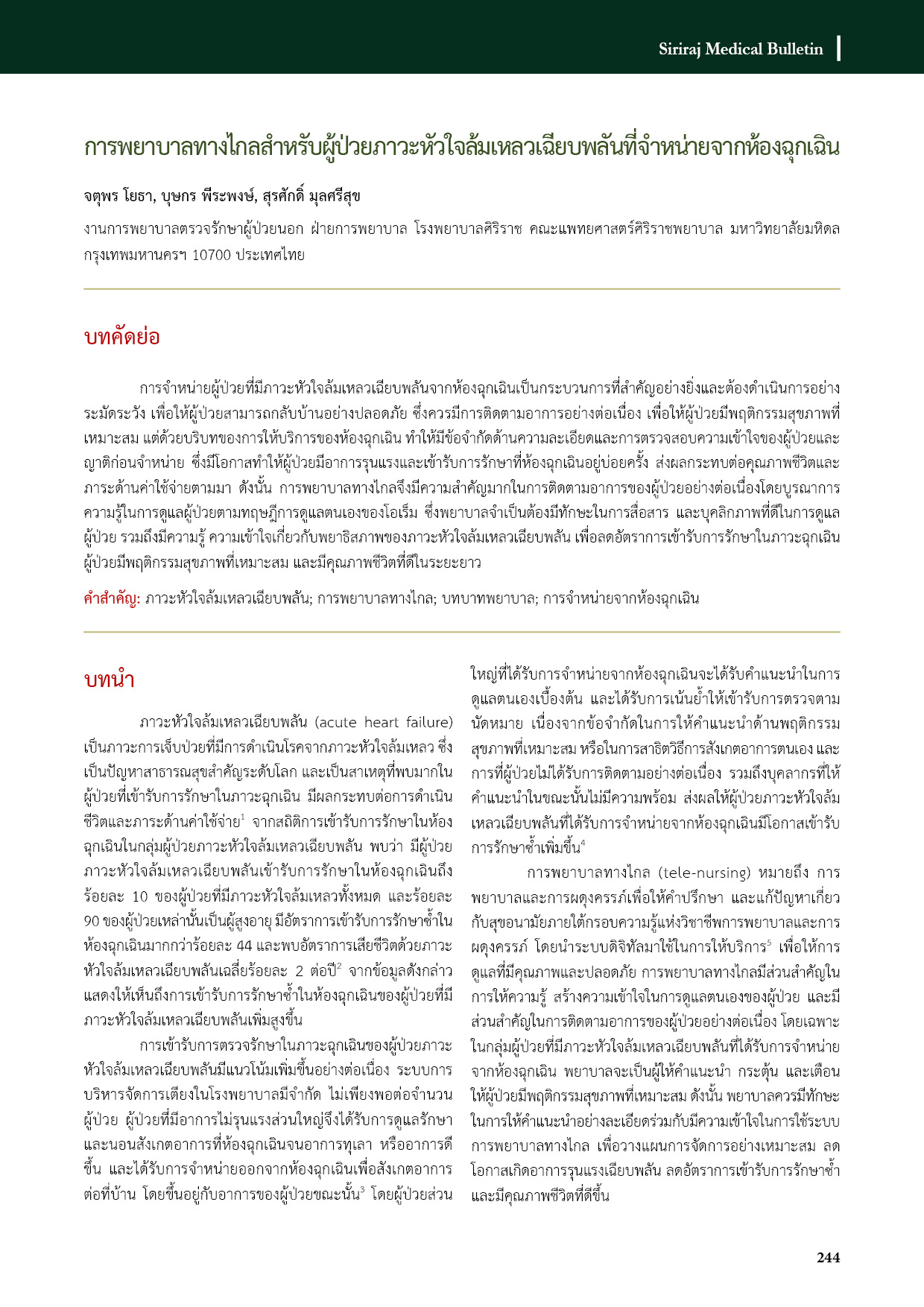Tele-Nursing for Heart Failure Patients Discharged from the Emergency Department
Main Article Content
Abstract
The discharge process for patients with acute heart failure from the emergency room is crucial and must be handled cautiously to ensure patient safety upon arriving home. Continuous monitoring is essential, requiring close observation of the patient's well-being. However, limitations within the emergency room setting may compromise the thoroughness of patient education and understanding before discharge. This can potentially lead to severe symptoms and frequent readmissions, impacting the patient's quality of life and healthcare costs. Therefore, remote nursing plays a vital role. By providing self-care knowledge based on Orem's theory, remote nurses can continuously monitor patients' conditions. Nurses with strong communication skills and a positive demeanor are essential for this role. Additionally, a deep understanding of acute heart failure pathophysiology is crucial. These nursing competencies can reduce emergency readmissions due to acute heart failure, promote patient self-care, and improve quality of life.
Article Details

This work is licensed under a Creative Commons Attribution-NonCommercial-NoDerivatives 4.0 International License.
References
Tersalvi G, Tersalvi G, Gasperetti A, Schiavone M, Jeroen Dauw, Gobbi C, et al. Acute heart failure in elderly patients: a review of invasive and non-invasive management. J Geriatr Cardiol. 2021;18(7):560–76.
สุรศักดิ์ มุลศรีสุข, สุปรีดา มั่นคง, นุชนาฏ สุทธิ. อาการและอาการแสดง การจัดการอาการด้วยตนเอง และการจัดการที่ห้องฉุกเฉินในผู้สูงอายุที่มีภาวะหัวใจล้มเหลว. วารสารสภาการพยาบาล. 2565;37(03):144-58.
Phrommintikul A, Buakhamsri A, Janwanishstaporn S, Sanguanwong S, Suvachittanont N. Heart Failure Council of Thailand (HFCT) 2019 heart failure guideline: Acute heart failure. J. Med. Assoc. Thai. 2019;102(3), 373-379.
ณัฐชญา ชัยผดุง, ศรินรัตน์ ศรีประสงค์, จงจิต เสน่หา, ฉัตรกนก ทุมวิภาต. ปัจจัยทำนายความพร้อมก่อนจำหน่ายจากโรงพยาบาลในผู้ป่วยหัวใจล้มเหลว. วารสารพยาบาลศาสตร์. 2566;41(1):73–86.
ประกาศสภาการพยาบาล เรื่อง แนวทางการพยาบาลทางไกล (Tele-nursing). ราชกิจจานุเบกษา เล่มที่ 138, ตอนพิเศษ 33 ง (ลงวันที่ 10 กุมภาพันธ์ 2564). เข้าถึงได้จาก https://www.tnmc.or.th/images/userfiles/files/T_0049.PDF
American Heart Association. Classes of Heart Failure [Internet]. Heart.org. American Heart Association; 2017. Available from: https://www.heart.org/en/health-topics/heart-failure/what-is-heart-failure/classes-of-heart-failure
Takagi K, Kimmoun A, Sato N, Mebazaa A. Management of acute heart failure during an early phase. Int J of Heart Fail. 2020;2(2):91.
Russell SD, Saval MA, Robbins JL, Ellestad MH, Gottlieb SS, Handberg EM, et al. New York Heart Association functional class predicts exercise parameters in the current era. Am. Heart J.. 2009;158(4):S24–30.
Orem D.E. Nursing: concepts of practice. 6th ed.London: Mosby; 2001.
Gupta AK, Tomasoni D, Sidhu K, Metra M, Ezekowitz JA. Evidence-based management of acute heart failure. Canadian J Cardiol. 2021;37(4).
Piscesiana E, Afriyani T. The Effect of tele-nursing on preventing re-admission among patients with heart failure: A literature review. Int J Nurs Health Serv. 2020;3(2):251–60.
Son YJ, Choi J, Lee HJ. Effectiveness of nurse-led heart failure self-care education on health outcomes of heart failure patients: A systematic review and meta-analysis. Int J Envi Res Pub Health. 2020;17(18):6559.






